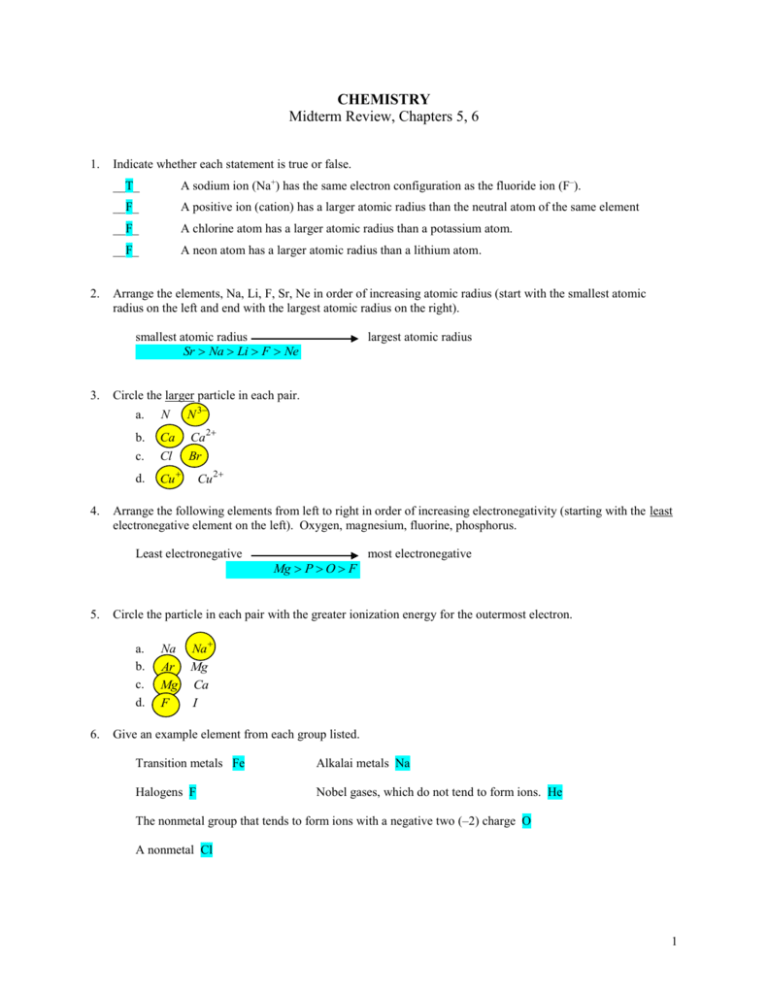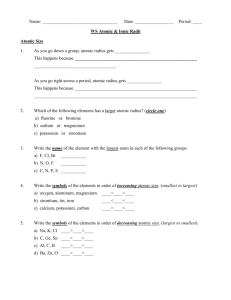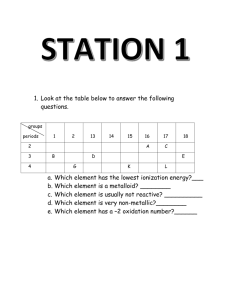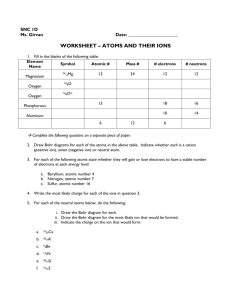chemistry - Fredericksburg Academy
advertisement

CHEMISTRY Midterm Review, Chapters 5, 6 1. 2. Indicate whether each statement is true or false. __T_ A sodium ion (Na+) has the same electron configuration as the fluoride ion (F–). __F_ A positive ion (cation) has a larger atomic radius than the neutral atom of the same element __F_ A chlorine atom has a larger atomic radius than a potassium atom. __F_ A neon atom has a larger atomic radius than a lithium atom. Arrange the elements, Na, Li, F, Sr, Ne in order of increasing atomic radius (start with the smallest atomic radius on the left and end with the largest atomic radius on the right). smallest atomic radius Sr Na Li F Ne 3. 4. Circle the larger particle in each pair. a. N N 3 b. Ca Ca 2 c. Cl Br d. Cu Cu 2 Arrange the following elements from left to right in order of increasing electronegativity (starting with the least electronegative element on the left). Oxygen, magnesium, fluorine, phosphorus. Least electronegative 5. Mg P O F most electronegative Circle the particle in each pair with the greater ionization energy for the outermost electron. a. b. c. d. 6. largest atomic radius Na Ar Mg F Na Mg Ca I Give an example element from each group listed. Transition metals Fe Alkalai metals Na Halogens F Nobel gases, which do not tend to form ions. He The nonmetal group that tends to form ions with a negative two (–2) charge O A nonmetal Cl 1 7. 8. 9. Identify the group and period for each element or identify the element for the given group and period. Element Symbol Group Number Period Number Br 17 4 Mg 2 (2A) 3 S 16 3 F 17 (7A) 2 Write the electron configuration for each ion. a. Mg 2 1s 2 2s 2 2 p 6 Ne b. F 1s 2 2s 2 2 p 6 Ne Write the ion, including the charge, that each atom is most likely to form. Ca Ca O 2 O S 2 S Cs 2 10. What is the electric charge on a. An ion with nine protons and ten electrons b. An ion with 12 protons and 10 electrons c. An ion with 34 protons and 36 electrons 11. Name each ion. Formula Cs 1− 2+ 2− Name PO 43 Phosphate SO 4 2 Sulfate NO3 Nitrate OH Hydroxide Cl Chloride N 3 Nitride 2 12. How many valence electrons does each atom have? O, 6 S, 6 Ca, 2 Na, 1 13. Write the electron configuration for each ion. a. Mg 2 1s 2 2 s 2 2 p 6 Ne b. O 2 1s 2 2 s 2 2 p 6 Ne c. Cu 2 Ar 3d 9 14. Write the ion typically formed by each atom. Atom Typical Ion O O 2 S S2 Ba Ba 2 Br Br P P 3 Na Na 15. Name each ionic compound, and write the ions from which it is made. Ionic Compound Compound Name Ions Ca OH 2 Calcium hydroxide Ca 2 OH Al2 O3 Aluminum oxide Al3 O 2 Ag 2O Silver oxide Ag O2 3 16. Write the correct formula of the compound formed by each pair of ions and write the name of the compound Cation Anion Compound Formula Compound Name Ba 2 PO 43 Ba 3 PO4 2 Barium phosphate Ca 2 SO 4 2 CaSO4 Calcium sulfate Na NO3 NaNO3 Sodium nitrate Al3 NO3 Al NO3 3 Aluminum nitrate Ag Cl AgCl Silver chloride Li PO 43 Li3PO4 Lithium phosphate K N 3 K3 N Potassium nitride Ag S2 Ag 2S Silver sulfide 4






